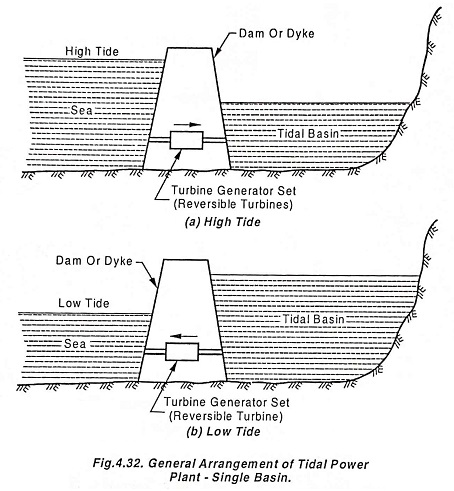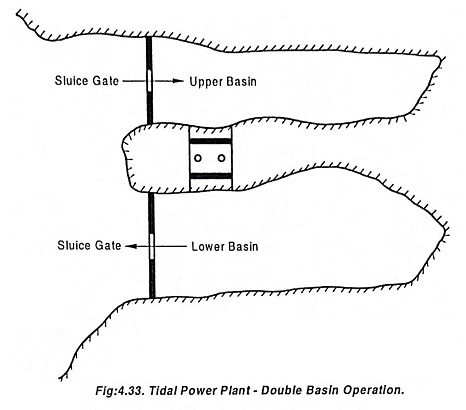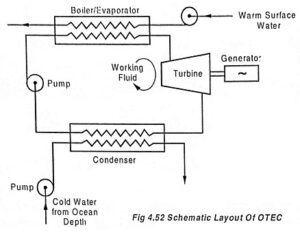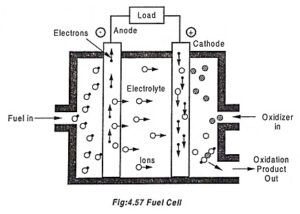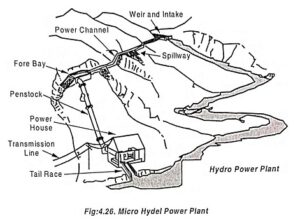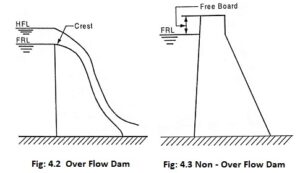Tidal Power Plant – Types and Working Principle:
Introduction to tidal power plant – Gravitational force between the moon, the sun and the earth causes the rhythmic rising and lowering of ocean water, around the world that results in tide waves. The moon exerts more force (twice) on the tides as the sun exerts, due to its much closer position to earth. Due to these forces tides are formed. Here the energy of tides is converted into useful form of power. Tidal power has more potential for future electrical generation and is more predictable than wind and solar energy.
The periodic rise and fall of the water level of sea which is carried out by the action of the sun and moon is called the ‘tide’.
- The large scale up and down movement of sea water represents an unlimited source of energy. If some part of this vast energy can be converted into electrical energy, it would be an important source of hydropower.
- The main feature of the tidal cycle is the difference in water surface elevations at the high tide and at the low tide. If this differential head could be utilized in operating a hydraulic turbine, then this tidal energy could be converted into electrical energy by means of an attached generator.
Components of Tidal Power Plants:
The following are the components of a tidal power plant. Refer Fig.4.32.
- The dam or dyke (low wall) to form the pool or basin.
- Sluice ways from the basins to the sea and vice versa.
- The power house.
Dam or dyke The function of dam or dyke is to form a barrier between the sea and the basin or between one basin and the other in case of multiple basins.
Sluice ways are used to fill the basin during the high tide or empty the basin during the low tide, as per operational requirement. These devices are controlled through gates.
Power house: A power house has turbine, electric generators and other auxiliary equipment.
1. Single basin arrangement
In a single basin arrangement, power can be generated only by intermittently. In this arrangement only one basin interacts with the sea. Sea and basin are separated by a dam and the flow between them is through sluice ways located conveniently along the dam. The rise and fall of tidal water levels provide the potential head.
Fig.4.32 shows a general arrangement of single basin tidal power plant (double cycle system). Such plants generally use reversible water turbines so that power is generated on low tide as well high tide.
The operation of the plant is as follows:
When the incoming tide sea level and tidal-basin level are equal, the turbine way is closed. When the sea level rises, the turbine valves are opened and the sea water flows into the basin through the turbine runner generating power. This also raises the level of water in the basin. The turbine continues to generate power until the tide passes through the turbine. Bypass valve then quickly opens to let water into the basin to gain maximum level. When sea and basin water level are equal, the valves are closed as well as the turbine conduit. The basin level then stays constant while the tide continues to go out. After sufficient head has developed, the turbine valves are again opened and water now flows from basin to the sea, thereby generating power. The plant continues to generate power till the tide reaches its lowest level.
2. Double basin arrangement
A single basin plant cannot generate power continuously, though it might do so by using a pumped storage plant if the load it supplies fluctuates considerably.
A double basin scheme can provide power continuously or on demand, which is a great advantage. The drawbacks is that the civil works become more extensive. In the simplest double-basin scheme there must be a dam between each basin and the sea and also a dam between the basins, containing the power house. One basin is maintained always a lower level than the other. The lower reservoir empties at low tide, the upper reservoir is replinshed at high tide. If the generating capacity is to be large, the reservoirs must be large which means that long dams would be required.
Advantages of Tidal Power Generation:
- Tidal power is completely independent of the precipitation (rain).
- Large area of valuable land is not required.
- When a tidal power plant works in combination with thermal or hydroelectric system peak power demand can be effectively met with.
- Tidal power generation is free from pollution.
Limitations of Tidal Power Generation:
- Due to variation in tidal range the output is not uniform.
- Since the turbines has to work on a wide range of head variation (due to variable tidal range) the plant efficiency is affected.
- Machineries are corroded due to corrosive sea water.
- It is difficult to carry out construction in sea.
- As compared to other sources of energy, the tidal power plant is costly.
- Sedimentation and silteration of basins.
- The power transmission cost is high because the tidal power plants are located away from load centres.

